Final report for EW16-027
Project Information
The Sustainable Grazing Management in Riparian and Wetland Pasture 3 Day Course took place on May 10-12, 2017 in the Owen Building large conference room at the Coos County Annex. The first two days of the course consisted of a half-day of classroom activities, primarily lecture, presentations, and discussion; and a half-day in the field completing one of two group exercises.
The location for the field portion of the first day of class was Windsong Ranch, owned by Pat Jones, who is also the Soil Conservationist for the Natural Resources Conservation Service in Coquille. Windsong Ranch is located on the South Fork Coquille River, which is known for its geomorphological and hydrological issues due to past gravel mining practices and other factors, including grazing. Participants were able to assess portions of the river bank that were actively eroding, and formed groups to assess the cause of the erosion and discuss possible preventative measures. Participants were also able to assess portion of river bank that appear to be stabilizing naturally, and to observe Pat's high-intensity riparian grazing management system in action. While on site participants also looked at forage species and discussed their various nutritional value and palatability; as well as weed management and control methods that Pat was using for undesirable toxic or invasive species.
The second day of class included a visit to the Pierce Ranch, where participants listened to the landowner (Dan Pierce) talk about the goals he has for his property, current management techniques, and challenges that he faces. Afterwards, participants again formed groups and walked segments of Offield Creek to assess riparian condition, discuss possible issues, and propose management alternatives and monitoring needs. Groups also discussed some of the issues relating to the failed tide gate and culvert, which have resulted in significant changes to the plant community and management in the lower pastures. Groups then worked together back in the classroom on day 3 to develop their recommendations into brief presentations on which were given at the end of class.
Objective 1. By improving the understanding of tools, concepts, thought processes, and principles of sustainable wetland and riparian grazing, natural resources professionals will be better able to work with other individuals, groups, and agencies to develop, teach, and implement successful grazing management strategies.
Objective 2. To develop two demonstrational areas on actual livestock operations: one which models on-the-ground best management practices for both livestock and wildlife use of riparian areas; and one which provides plenty of material for discussion and management planning exercises.
Objective 3. To instill a foundational understanding of the ecological services which healthy riparian zones and wetland areas provide, and best management practices necessary to sustainably use these areas for livestock grazing.
Objective 4. To provide a hands-on learning experience in which participants of the course will be given an actual livestock operation situation, and using a collaborative adaptive management approach, design grazing management alternatives to achieve riparian objectives.
Objective 5. To create a forum in which natural resources professionals; state and federal agency personnel; and local agricultural producers can explore the various influencing factors surrounding sustainability of grazing in sensitive riparian and wetland areas.
The sustainability of livestock operations along the Oregon coast and in the Pacific Northwest in general is closely tied to the sustainability of riparian and wetland areas. This is certainly true here in the Coquille Watershed, which will be the site of our proposed training. The Coquille is an alluvial river, which means that the channel is self-formed, shaped by the magnitude and frequency of floods. The bed and banks are made up of mobile sediment and soil which is continually eroded, transported, and deposited. Historically, much of the lower reaches of the river were diked, tide gates installed, wetlands filled, and estuaries drained to allow for agricultural operations to make use of the fertile soils along the river valley. The rise and fall of the water level and heavy flooding in winter continued to prevent many types of agriculture, but the high-value forage that grows in the valley lowlands makes this area ideal for seasonal grazing. The lower river area also continues to be a very important rearing environment for anadromous fish such as shad and juvenile Chinook and Coho salmon.
Recently, several notably large restoration efforts designed to restore and enhance fish habitat along the lower river have given rise to a heated political climate in our watershed. Additionally, the historic infrastructure of dikes and tide gates which once enabled the lower river valley to be farmed has begun, due to the natural effects of time and weather, to fail. The result is the reestablishment of marsh and wetland habitat in what has, often for the entirety of that landowner’s lifetime, been known as prime pasture. State and federal regulations prevent landowners from simply going out and repairing their dikes or replacing tide gates as their fathers and grandfathers once would have done. Now a permit must be obtained, and the process can be long, complicated, and sometimes expensive.
In the Coquille Watershed, if you were to take a drive along the lower river today you would encounter numerous signs that proclaim slogans such as “Save Family Farms; Say NO to Wetlands!” or “NO Marsh Expansion: Ranchers feed families, provide wildlife habitat, and preserve open space.” These signs are indicative of the current divide in political views surrounding the issues of natural resources conservation efforts, and local agriculture. Many local producers fear that the future of agriculture along the Coquille River is in grave danger due to increasing regulations designed to protect wetland areas. There is a general prevalence of false information, misunderstanding, fear, and mistrust of state and federal agencies in the Coquille watershed. This course could be highly beneficial to our area by helping to expel some of that misinformation and promote a more balanced understanding of the goals of natural resources professionals, state and federal agency personnel, and the needs and challenges of local agricultural producers.
Cooperators
- - Technical Advisor
- - Technical Advisor
- - Technical Advisor
- - Technical Advisor
- - Technical Advisor
- - Technical Advisor
Education
COURSE OUTLINE
Grazing Management for Riparian-Wetland Areas
Coquille, OR
May 10-12, 2017
Tuesday, May 09, 2017
|
8:30 – 5:00 |
Field Exercise Site Review by Team |
Wednesday, May 10, 2017
|
9:00 – 9:45
|
Introduction Caley & Sandy A. Purpose & Overview of Course B. Training Materials and Reference Review C. Grounding of course
|
|
9:45 – 10:30 |
Grazing Management Principles and Practices Related to: Chris S. A. Diet Selection B. Habitat Selection C. Targeted Grazing |
|
10:30 – 10:45 |
Break |
|
10:45 – 11:15 |
Riparian and Wetland Soils Sandy |
|
11:15 – 11:45 |
Riparian and Wetland Plants/Communities Sandy |
|
12:00 – 1:00 |
Lunch |
|
1:00 – 2:00
|
Grazing Management Planning Chad A. Riparian Physical Function B. Integrated Riparian Management Process (IRMP) C. Developing Management Objectives
|
|
2:00 – 4:30
|
Field Exercise Sandy/Chad A. Walk stream reaches and wetlands to discuss riparian physical function and soils |
Thursday, May 11, 2017
|
8:00 – 8:45
8:45 – 9:45
|
Managing Disturbance Driven Ecosystems Dave
Key Grazing Management Strategies Dave A. Timing, Duration, and Frequency of Grazing B. Utilization Levels and Patterns C. Pasture Design D. Wildlife
|
|
|
|
|
9:45 – 10:00 |
Break |
|
10:00 – 11:00
|
Animal Tools and Techniques (Sandy) |
|
11:00 – 11:30
|
Grazing Management Treatments (Sandy) A. Examples of grazing management treatments and changed condition.
|
|
11:30 – 12:30 |
Travel to field site and lunch |
|
12:30 – 4:30
|
Group Exercise (Sandy) A. Planning assignment for group exercise in a field setting. (Sandy) Friday, May 12, 2017 |
|
8:00 – 9:00
|
Monitoring (Sandy) A. Short-Term Monitoring (Implementation) B. Mid and Long-Term Monitoring C. Photo Monitoring
Evaluate Progress (Dave) |
|
9:00 – 9:30 |
Seeding Recommendations (Sandy/Cassie)
|
|
10:00 |
Travel to Field
|
|
|
Field Exercise (Continued) A. Look at stream reaches/wetlands in teams
|
|
|
Group Plan Presentations (Sandy) A. Develop group plans B. Each team will develop a brief presentation which include: 1. Goal(s) based on the issues 2. Objective(s) including what, which direction, how much, where, and when, 3. Selected management alternative including livestock management, infrastructure, sequence of steps, etc. 4. Monitoring method(s)
|
|
Done by 3 p.m.
|
What have we learned and course evaluation/wrap up (Sandy)
|
Education & Outreach Initiatives
To improve the understanding of tools, concepts, thought processes, and principles of sustainable wetland and riparian grazing, and enable natural resources professionals to better work with other individuals, groups, and agencies to develop, teach, and implement successful grazing management strategies.

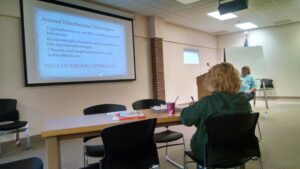
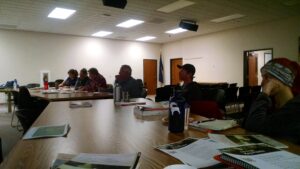
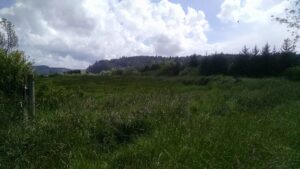
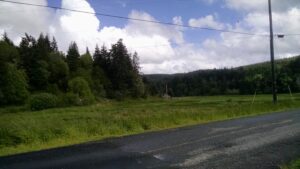
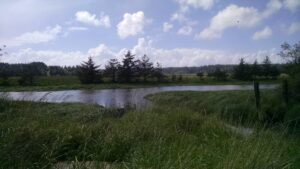
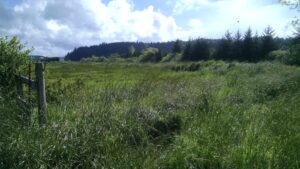
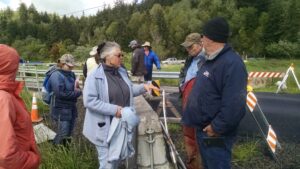
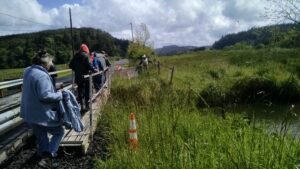
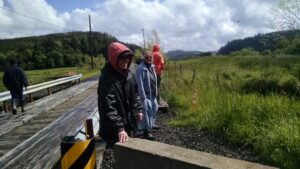
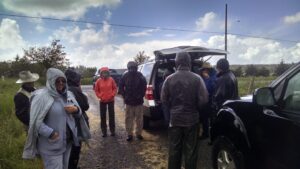
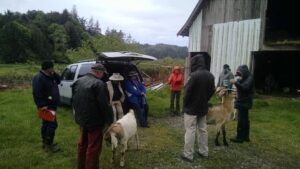
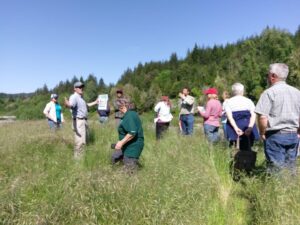
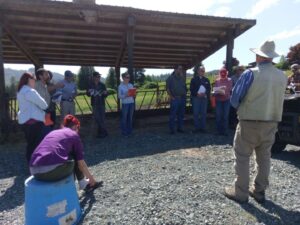
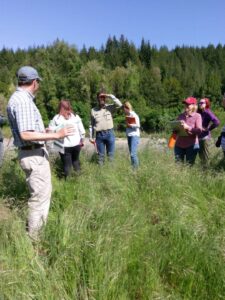
Evaluation Questions:
What did you learn about this workshop that will be useful to you?
- This information will be useful to me in my future career, especially working with landowners on how they can manage their riparian pastures and how they can incorporate that into a grazing management plan. – Rushal Sedlemeyer (Natural Resources/Fish & Wildlife Degree Student, Oregon State University)
- How to be/think more flexibly about management- especially in thinking about working to meet natural resource and production goals. Also (I know this isn’t a complete sentence) really thinking about site history, current condition, and how to evaluate stream/riparian functionality. – Cassie Bouska (OSU Extension Faculty, Agriculture)
- Strategies for managing riparian areas where livestock exclusion is not an option, or not the best option. –Drew Harper (Riparian Restoration Specialist, Curry SWCD)
- How to use livestock as a tool. -Greg Stone (local land/livestock owner, Coos Watershed Director)
- Some of the practices that I am using, that will improve my production of cattle. –Mark Stoller (local rancher)
- More familiarity with the language (technical terms) of the science of pasture/grazing management, hydrology, and cattle behavior and biology. –Bonnie May (local landowner)
- Details of animal behavior and growth cycles of forbs and grasses. –Howard Crombie (Executive Director, Wild Rivers Land Trust)
- A better understanding of and appreciation for the “art and science” of range management and a better understanding of cattle behavior. –Leigh Ann Vradenburg (Projects Manager, Klamath Basin Partnership)
- The diet selection part put on by Chris was excellent review of principles of livetock forage use. -Christopher Claire (Habitat Protection & Conservation Biologist, ODFW)
- The presentations on diet selection and cattle behavior definitely stood out to me as some of the most useful information as far as gaining a better understanding of how and why livestock graze on certain species more than others, or tend to prefer to occupy certain parts of the landscape more than others. I was very intrigued to learn about how these various preferences how this can be a part of/influenced by an animal’s breed, age, and maternal influence, as well as species. –Caley Sowers (Watershed Technical Specialist, Coos SWCD)
What actions do you intend to take as a result of what you learned?
- I feel more prepared to enter a career in this field and connect with landowners and other organizations on these issues. This workshop has also got me thinking on possible master’s programs to further my education on these topics. – Rushal Sedlemeyer (Natural Resources/Fish & Wildlife Degree Student, Oregon State University)
- Have more conversations with landowners. – Cassie Bouska (OSU Extension Faculty, Agriculture)
- Working with landowners to determine if this type of management is something they are interested in and willing to try. –Drew Harper (Riparian Restoration Specialist, Curry SWCD)
- To be more proactive on my [land] ownership. – (local land/livestock owner, Coos Watershed Director)
- Will utilize assessment tools and techniques to assess and develop a pasture management plan on my 55 acres. –Bonnie May (local landowner)
- Investigate successful examples of riparian grazing in western Oregon. Ask rancher friends to educate me more about their practices. Observe pasture growth and grazing cycles more closely. –Howard Crombie (Executive Director, Wild Rivers Land Trust)
- Discuss management techniques with managers, rather than fencing as the only option. And, see what local case examples of successful riparian grazing management are available. –Leigh Ann Vradenburg (Projects Manager, Klamath Basin Partnership)
- I will look for more opportunities to assist ranchers/farmers with improving forage quality.–Christopher Claire (Habitat Protection & Conservation Biologist, ODFW)
- I definitely want to gain a more in depth knowledge of local forage varieties and more hands-on experience with developing grazing plans with landowners. I still think fencing is going to be necessary in more cases than not in our region, but I am ore open now to exploring alternative management options especially with landowners who exhibit high energy and commitment. –Caley Sowers (Watershed Technical Specialist, Coos SWCD)
What steps will you take to know whether you are meeting your goals?
- Monitoring, evaluation, and adaptive management. – Rushal Sedlemeyer (Natural Resources/Fish & Wildlife Degree Student, Oregon State University)
- Monitor proper attributes of strategies and objectives. –Drew Harper (Riparian Restoration Specialist, Curry SWCD)
- Take pictures, keep notes, journal. –(local land/livestock owner, Coos Watershed Director)
- Will monitor actions and management changes implemented to determine results and adjust as necessary. –Bonnie May (local landowner)
- I will ask more questions of rancher friends. –Howard Crombie (Executive Director, Wild Rivers Land Trust)
- Developing a few grazing plans over the next year or two, seeing how they are implemented by landowners, and modifying my approaches accordingly. I will use some of the evaluation and monitoring techniques discussed in this course to track effectiveness. –Caley Sowers (Watershed Technical Specialist, Coos SWCD)
Did this course meet your expectations? Please explain:
- Yes, the presentations were easy to follow and very engaging. The small group discussions and field trips were also very engaging. I enjoyed meeting the presenters, people in my community, and other interested people. – Rushal Sedlemeyer (Natural Resources/Fish & Wildlife Degree Student, Oregon State University)
- Yes! –Cassie Bouska (OSU Extension Faculty, Agriculture)
- Exceeded; the amount of valuable and constructive discourse was very rewarding. –Drew Harper (Riparian Restoration Specialist, Curry SWCD)
- Exceeded; I learned way more than course title. Technical and Policy information as well. –(local land/livestock owner, Coos Watershed Director)
- Somewhat; more landowners needed to balance out government agencies. Also would like to have seen more examples from this area, as compared to Midwest/intermountain areas. –Mark Stoller (retired, local rancher)
- Yes; course provided a wealth of information from great people and teachers with hands on experience and case-study examples to share. –Bonnie May (local landowner)
- Yes and No; I learned a lot about grazing in general and about riparian grazing in the western US. I understand physics is physics, but the hydrology, plants, and private land grazing in western Oregon may be different enough from the rest of the west that I remain skeptical in the general compatibility of riparian grazing with riparian health in western Oregon. –Howard Crombie (Executive Director, Wild Rivers Land Trust)
- Yes, very professional staff. –Christopher Claire (Habitat Protection & Conservation Biologist, ODFW)
- Yes and No; there was a wealth of information and the presenters were great but I do wish they would have included some more local examples or done a bit more homework to familiarize themselves with local plant species, hydrologic issues, etc. Also, I kept getting the impression that some of the presenters were almost advocating against riparian restoration, and one presenter even at one point said that “trees will not make the water colder.” However, the effects of shade on stream temperatures is well-documented science and the last thing I would want to be doing is encouraging or confusing landowners that maintaining a healthy vegetated riparian buffer is not beneficial or necessary. –Caley Sowers (Watershed Technical Specialist, Coos SWCD)
Educational & Outreach Activities
Participation Summary:
Learning Outcomes
Project Outcomes
Impacts
The intended outcome for the participants of this course was for them to leave with a greater understanding of the various influencing factors surrounding sustainability of grazing in sensitive riparian and wetland areas. Natural resources professionals, upon completion of this training, should also have a more thoroughly developed ability to teach and implementing successful grazing management strategies.
For the agricultural landowners, we hope that by utilizing the methods and techniques covered in this course they are able to improve the quality and sustainability of their operations and become better stewards of the land. All participants will be left with a clear understanding of the ecological services which healthy riparian zones and wetland habitat provides, and best management practices to sustainably use these areas for livestock grazing.
Accomplishments
The course took place as planned on May 10-12th, 2017.
The number of participants in the workshop was not as great as we had hoped, with only 19 total individual participants, most of which were unable to attend all three days. 9 participants were able to attend the entire 3-day course; 7 were able to attend only one day; and 1 participant was able to attend two days. However, out of the participants that did attend all or some part of the course, we had a great diversity of backgrounds, ranging from a student, to natural resources professionals with varying levels of experience, to representatives of regulatory agencies, to local landowners (see table below).
|
Day 1 Participants (17 Total) |
Day 2 Participants (10 Total) |
Day 3 Participants (11 total) |
|
Caley Sowers (watershed Technical Specialist, Coos SWCD) |
Caley Sowers (watershed Technical Specialist, Coos SWCD) |
Caley Sowers (watershed Technical Specialist, Coos SWCD) |
|
Leigh Ann Vradenberg (Project Manager, Klamath Watershed Partnership) |
Leigh Ann Vradenberg (Project Manager, Klamath Watershed Partnership) |
Leigh Ann Vradenberg (Project Manager, Klamath Watershed Partnership) |
|
Drew Harper (Riparian Restoration Specialist, Curry SWCD) |
Drew Harper (Riparian Restoration Specialist, Curry SWCD) |
Drew Harper (Riparian Restoration Specialist, Curry SWCD) |
|
Barbara Grant (CREP Tech, Curry SWCD) |
|
|
|
Allison Tarbox (Uplands Restoration Projects Manager, Coos Watershed Association) |
|
|
|
Dave Nelson (Riparian Stewardship Crew Leader, Coos Watershed Associaiton) |
|
|
|
Shawna Faulkner (Lowlands Restoration Projects Manager, Coos Watershed Association) |
Shawna Faulkner (Lowlands Restoration Projects Manager, Coos Watershed Association) |
Shawna Faulkner (Lowlands Restoration Projects Manager, Coos Watershed Association) |
|
Pat Jones (NRCS Soil Conservationist and local rancher) |
|
|
|
Howard Crombie (Wild Rivers Land Trust) |
Howard Crombie (Wild Rivers Land Trust) |
Howard Crombie (Wild Rivers Land Trust) |
|
Bonnie May (landowner) |
Bonnie May (landowner) |
Bonnie May (landowner) |
|
Rushal Sedlemeyer, (OSU Natural Resources Student) |
Rushal Sedlemeyer, (OSU Natural Resources Student) |
Rushal Sedlemeyer, (OSU Natural Resources Student) |
|
Chris Claire (ODFW Habitat Conservation and Protection Biologist) |
|
|
|
Greg Stone (landowner, Coos Watershed Association Director) |
Greg Stone (landowner, Coos Watershed Association Director) |
Greg Stone (landowner, Coos Watershed Association Director) |
|
Mark Stoller (landowner) |
Mark Stoller (landowner) |
Mark Stoller (landowner) |
|
Caleb Mentzer (Program Manager, Coquille Watershed Association) |
|
|
|
Cassie Bouska (OSU Extension Faculty, Agriculture Department) |
|
Cassie Bouska (OSU Extension Faculty, Agriculture Department) |
|
Joan Mahaffey (Landowner) |
|
|
|
|
Dan Pierce (Coos SWCD Director, local rancher) |
|
|
|
|
Beth Pietrzak (Regional Ag Water Quality Specialist, ODA) |
All participants were asked to fill out a course evaluation form. The responses on the evaluation forms are summarized as follows (each x represents one participants score for that item; not all participants scored every box):
How would you rate each of the following?
|
Course |
Needs improvement |
Satisfactory |
Good |
Excellent |
Comments |
|
Organization |
xx |
xxx |
xxx |
“Great job coordinating all the moving parts”- Bonnie May (local landowner)
“Coordinate overlap”- Rushal Sedlemeyer (Natural Resources/Fish & Wildlife Degree Student, Oregon State University) |
|
|
Materials |
x |
x |
xx |
xxxxx |
“Really appreciate how you walk us through all of it at the beginning- I’m going to do that at my upcoming classes!” – Cassie Bouska (OSU Extension Faculty, Agriculture)
“Should be more localized to Southwest Oregon.”- (local land/livestock owner, Coos Watershed Director)
“Nice variety of material.”- Bonnie May (local landowner)
“Copies of powerpoint presentations would have been great.”- Howard Crombie (Executive Director, Wild Rivers Land Trust) |
|
Presentations |
Needs improvement |
Satisfactory |
Good |
Excellent |
Comments |
|
Managing Disturbance Driven Ecos. |
x |
xxxx |
x |
||
|
Riparian/Wet. Soils |
x |
x |
xxxx |
xx |
|
|
Riparian/Wet. Vegetation |
x |
xxxxxx |
xx |
||
|
Grazing Mgt. Planning |
x |
xxxxx |
xx |
||
|
Key Grazing Mgt. Strategies |
xxxxx |
xxx |
|||
|
Mgt. Tools & Techniques |
xx |
xxxx |
xx |
||
|
Graz. Diet & Hab. Selec.; Target grz. |
xxxx |
xxxx |
“Glad Chris was able to fill in- I think more emphasis on how to relate Principles from range research on east side to what we deal with here, would help local producers connect with material better.”- Cassie Bouska (OSU Extension Faculty, Agriculture)
“Chris was knowledgeable and provided many new things for a non-cattle person such as myself.”- Leigh Ann Vradenburg (Projects Manager, Klamath Basin Partnership) |
||
|
Grz. Mgt. Treatments |
xx |
xxxx |
xx |
“There was some duplication between Sandy and Dave on day 3”- Leigh Ann Vradenburg (Projects Manager, Klamath Basin Partnership) |
|
|
Monitoring |
x |
x |
xxxx |
xx |
|
|
Evaluate Progress |
x |
xx |
x |
||
|
Seeding Recommend. |
xx |
xx |
|||
|
Group Field Exercise Day 1 |
xxxxx |
xxxx |
“Great tour, liked the opportunity to try to implement what we’d learned.”- Cassie Bouska (OSU Extension Faculty, Agriculture)
“Not enough time, goals and objectives of visit were not always clear.”- Howard Crombie (Executive Director, Wild Rivers Land Trust)
“Pat’s information was very helpful in understanding thought processes & level of effort; however, looking at the cut bank area we got off track with any management connection.”- Leigh Ann Vradenburg (Projects Manager, Klamath Basin Partnership)
“Great site for discussion.” –Christopher Claire (Habitat Protection & Conservation Biologist, ODFW) |
||
|
Group Field exercise Day 2 |
xxxx |
xxxxx |
“Missed day 2, but the final group day was great- productive!”- Cassie Bouska (OSU Extension Faculty, Agriculture)
“Good tie-in with various elements of training”- Leigh Ann Vradenburg (Projects Manager, Klamath Basin Partnership)
“I enjoyed the small-group discussion and working as ID teams.”- Rushal Sedlemeyer (Natural Resources/Fish & Wildlife Degree Student, Oregon State University) |
||
|
Overall Course |
x |
xxx |
xxx |
“Would like to have access to power-point presentations online. So much great information and photos in the presentations. A lot to take in, but really good info- Thanks.”- Bonnie May (local landowner)
“Need more west-side case studies. Need discussion of nutrient inputs into streams from riparian grazing.”- Howard Crombie (Executive Director, Wild Rivers Land Trust)
“Of repeated for coastal systems, course would benefit from more materials focused on coastal systems.” –Christopher Claire (Habitat Protection & Conservation Biologist, ODFW) |
The following responses were recorded from participants' workshop evaluation forms:
What recommendations do you have for the improvement of this course?
- I don’t have any recommendations, but I did like the laid –back setting so keep it up! – Rushal Sedlemeyer (Natural Resources/Fish & Wildlife Degree Student, Oregon State University)
- Define big scientific words…producers will probably be afraid to ask. – Cassie Bouska (OSU Extension Faculty, Agriculture)
- Tailor curriculum and material more to our southwest Oregon locale. –Greg Stone (local land/livestock owner, Coos Watershed Director)
- Would have been great to have a sense of the depth of the material to be covered in advance to better prepare for material absorption. –Bonnie May (local landowner)
- More case studies from western Oregon/Washington, a general “Intro to Livestock Management” PowerPoint for novices like me, and more discussion of livestock nutrient inputs into streams. –Howard Crombie (Executive Director, Wild Rivers Land Trust)
- The course would benefit from more focus on coastal conditions and plant communities, and resource goals for coastal systems if presented in a coastal system again. –Christopher Claire (Habitat Protection & Conservation Biologist, ODFW)
- It seemed like the standards for proper functioning condition were somewhat low; also I would like more discussion about the benefits of riparian zones, why shading streams is important, and some acknowledgement of the nutrient/sediment inputs to streams from livestock use. Also I would like more focus on local/coastal ecosystems, plants, and natural resources issues. –Caley Sowers (Watershed technical Specialist, Coos SWCD)
Would you recommend this course to others? Please explain.
- Yes, it would be nice to see more landowners take this course and engage with people from all these disciplines and work together on “grazing management plans” because they have great perspectives too! – Rushal Sedlemeyer (Natural Resources/Fish & Wildlife Degree Student, Oregon State University)
- Yes – Cassie Bouska (OSU Extension Faculty, Agriculture)
- Yes, anyone who manages or works with managers of livestock and riparian areas would benefit from taking this course. –Drew Harper (Riparian Restoration Specialist, Curry SWCD)
- Yes; excellent course! Almost a full course with projects and team/group work crammed into 3 days. –Bonnie May (local landowner)
- Yes; very good information, presenters, discussions. –Howard Crombie (Executive Director, Wild Rivers Land Trust)
- Yes –Christopher Claire (Habitat Protection & Conservation Biologist, ODFW)
- Yes but with caution; there is potential for this to be a highly beneficial course but it should be known beforehand what audience you are targeting, and where the presentors are coming from. For the organization hosting this training, do your homework and make sure they are tailoring their presentations to fit your regions/ organizations goals. That being said I’m still glad for the experience and I learned a lot, though not necessarily on all the topics I had hoped and more on some I hadn’t even considered. –Caley Sowers (Watershed technical Specialist, Coos SWCD)
Other comments:
- More students like me should come to these classes! – Rushal Sedlemeyer (Natural Resources/Fish & Wildlife Degree Student, Oregon State University)
- 3 days is very appropriate for this course. Although riparian-wetland, I could use another more general class on pasture/livestock management. –(local land/livestock owner, Coos Watershed Director)
- Excellent instructors/instruction and presentations by Sandy Wyman, Chad, Dave, and Chris. Appreciate the reference material and Caley’s great organizational skills and flexibility in trying to accommodate everyone’s time constraints. –Bonnie May (local landowner)
- Again, I need more examples of west-side riparian grazing to be convinced that it can be successful here. The course needs to not just focus on the geomorphological effects of grazing management. Nutrients are also a major concern. –Howard Crombie (Executive Director, Wild Rivers Land Trust)
- There was much discussion of the benefits of having landowners implement rotational grazing plans, but most of the examples were based on operations in the Midwest, or eastern Oregon, where landowners are grazing on public lands by permit, and subject to meeting certain restrictions/requirements. Around here, most farm/grazing land is privately owned and so we (agencies) have no power of enforcement. This means it is entirely up to the landowner to do the work and this is fine for committed, motivated landowners. But in this region there’s a tendency towards smaller operations and landowners who only raise livestock as a second job or supplemental income (they still have to work full-time) and they don’t have the means or resources to commit to a high intensity level of management. In addition, it is very difficult to obtain funding for anything that doesn’t carry some kind of protection or guarantee. We would never be able to get a grant to pay for riparian restoration on a stream where there was no riparian exclusion fencing to protect the plantings, and similarly there is no or very little funding for agency personnel to work with landowners to develop voluntary grazing plans or do forage monitoring unless it is attached to some kind of water-quality or fish-habitat quality enhancing effort. This is the reality of the Oregon Coast and I wish that had been addressed. –Caley Sowers, (Watershed Technical Specialist, Coos SWCD)